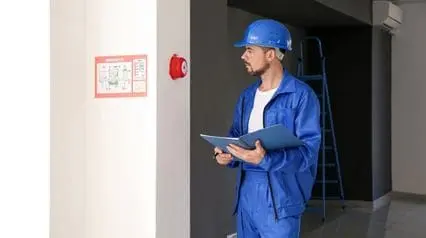What is Fire Risk Assessment?
Fire risk assessment is an essential element of fire safety management in the workplace. This aims to identify potential fire hazards and the people who may be affected, evaluate the risks associated with the perceived hazard, and implement measures to eliminate or, at the very least, reduce those risks.
According to the US National Fire Protection Association (NFPA), fire departments responded to emergencies every 23 seconds in 2021. Fatal injuries happen every two hours, nonfatal injuries occur every 36 minutes, and property damage cost over $15 billion. The statistics are also alarming in Australia where many workers cannot operate a fire extinguisher. In the UK, there is a 16% increase in fire incidents in 2022 compared to the previous year.
All these facts point to one thing: fire safety assessment is vital.
Importance
Emergencies like a fire breaking out happen when least expected. The only way to successfully deal with this is to be ready. A critical part of the preparation is fire risk assessment. Here are specific reasons for doing it as soon as possible:
- Recognize risks – Poorly maintained electrical lines and inadequate safety equipment are not immediately apparent to workers. But by going through the nooks and crannies of the workplace, assessors can identify potential causes of fire and make suggestions on how to deal with it.
- Allocate resources properly – Hazards come in different shapes and forms, and it’s unbelievably expensive to address all of them at once. Evaluations allow managers to prioritize tasks.
- Save on costly repairs and revamps – Fires, if unchecked, can obliterate everything. Not only is damage restoration expensive for the company, but it also halts operations.
- Comply with regulations – Conducting checks is a must according to the law. If a company fails routine fire risk evaluation by government inspectors, they face hefty fines or closures.
- Potentially save lives – Ultimately, the goal of conducting this at the workplace is to ensure people’s health and safety. Equipment maintenance and provision of appropriate training help minimize or eradicate hazards. And if the unfortunate happens, they would know how to keep themselves and others safe.
Process
Similar to a general risk assessment, a fire risk assessment involves several steps. Although this takes a considerable amount of company time and resources, meticulously going through each step is necessary because this is a matter of life and death.
Identify Fire Hazards
Fire hazard assessment is a key component of the process. This identifies the possible source of the fire and the type of fire it can create.
- Class A
- Potential hazards: Common combustibles like wood, paper, and cloth
- Usual setting: Carpentry shops, textile factories, boutiques, and offices.
- Class B
- Potential hazards: Flammable liquids and gases like oil, gasoline, and propane tanks
- Usual settings: Restaurants, various food manufacturing facilities, and car repair yards.
- Class C
- Potential hazards: Any electrical equipment like computers and appliances
- Usual settings: Factories for manufacturing, warehouses for electrical items, electrical repair shops, and offices.
- Class D
- Potential hazards: Combustible metals like magnesium, sodium, and potassium, and possible chemical reactions
- Usual settings: Research laboratories, engineering factories, storage warehouses, and waste treatment and disposal facilities.
- Class K
- Potential hazards: Cooking oil, grease build-up, and unattended cooking equipment
- Usual settings: Restaurants, coffee shops, and food kiosks.
Identify People at Risk
This is a crucial step because it allows managers to provide their employees with the appropriate protective equipment and, more importantly, adequate safety training. Aside from the individuals who are directly involved in the activity, the people around them should also be protected from risks.
Evaluate Existing Safety Measures
This step involves checking the safety measures put in place and ensuring that these are effective in current circumstances and in compliance with regulations. Here are some factors evaluated:
- Evacuation plans, including adequate signs and lighting
- Clear pathways to exit doors
- Working fire extinguishers and accessories
- Water sprinklers
- Smoke detection systems
- Smoke suppression systems
- Equipment maintenance
- Fire retardant materials in interiors
- Accessibility to firefighters
- Frequency of fire drills
- Adequate training for safety officers and employees
Assess Risks for Fire
In this part of the process, evaluators specifically consider the likelihood of a fire breaking out and the extent of damage it could create based on the assessment. These are some factors checked:
- Ignition source
- Fuel source
- Oxygen supply
Assessors also consider how fires could start so that they can provide additional measures for prevention:
- Accidental (e.g., when small flames are not fully put out)
- Act of omission (e.g., when equipment is not maintained)
- Deliberate (e.g., arson attack)
Create Your Own Fire Risk Assessment Checklist
Eliminate manual tasks and streamline your operations.
Get started for FREERecord Findings
The final step in fire risk assessment is documentation. Record keeping upholds current best practices and allows companies to work on possible amendments to fire safety procedures. Improvements include the following:
- Replacement of faulty equipment
- Additional or continued training for workers
- Modifications in your existing fire safety procedure due to the hiring of new employees or changes in the landscape of your workplace
Who Should Conduct Fire Risk Assessments?
According to legal guidelines, “competent people” should conduct a fire risk assessment. There is no specific definition provided, but many agree that this means highly knowledgeable in the subject and duly accredited by regulatory offices.
Small to medium enterprises often employ the services of fire safety professionals from their local fire department or health and safety services office. Larger companies usually have a team in place.
It doesn’t matter who is charged to carry out this job as long as they are trained and certified. They should also strictly follow the process so they don’t miss anything that could potentially cause a fire emergency in the future.
FAQs about Fire Risk Assessment
The guidelines consider the location and the age of a particular structure. Here is an example in the UK:
- Reviews must be done annually.
- A new assessment is conducted every five years.
- Another assessment is also done if:
- The purpose of the building changed
- The structure changed
- The number of occupants increased
There is no specific period set in some countries as long as it is conducted regularly. It would still be best to check local policies for this.
Yes, this is a legal requirement if your address is not a single private dwelling. In addition, companies that employ five or more people should have a written record of their fire risk assessment.
Building owners are considered the “responsible person.” If a particular building houses different businesses, the owners of each company are mandated by law to conduct their fire risk assessment.
Fires are much too dangerous, and any preventive measure should not be taken lightly. If the law is not followed, the “responsible person” may be prosecuted, resulting in hefty fines or prison sentences.




